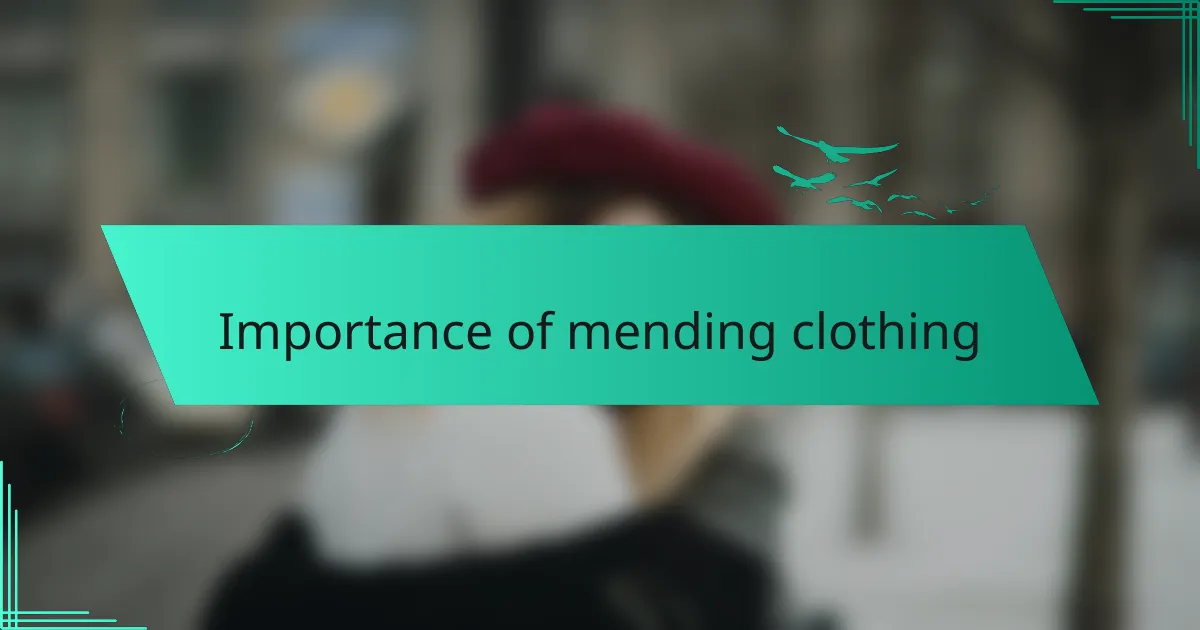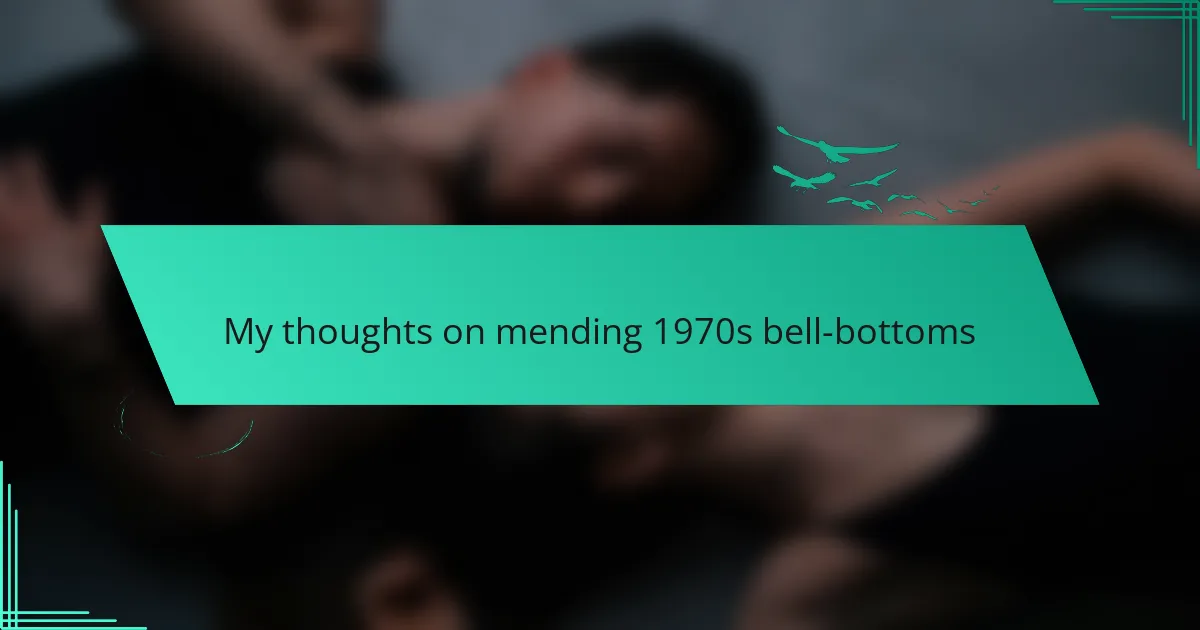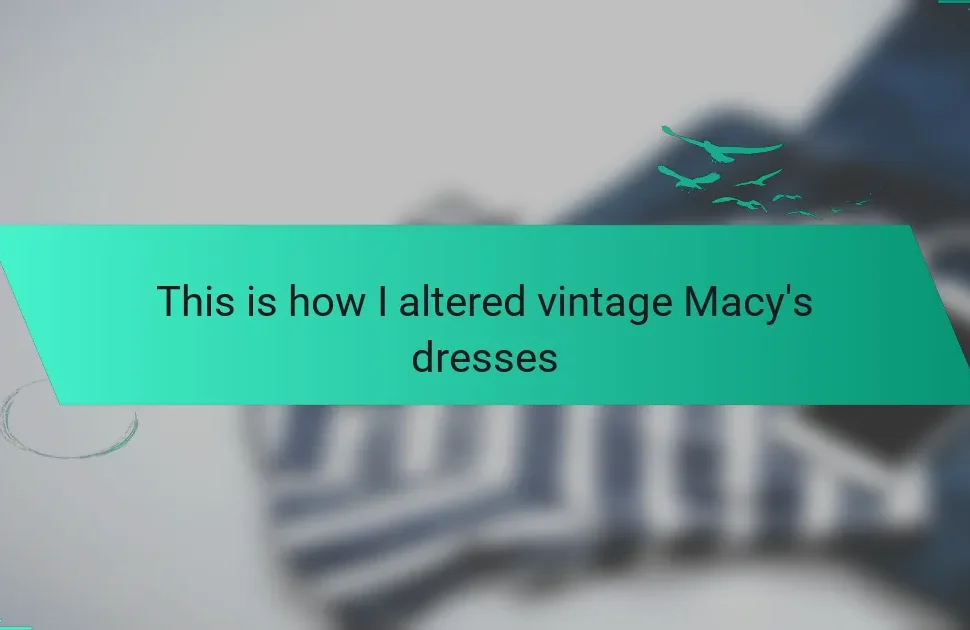Key takeaways
- Understanding vintage fashion DIY fosters creativity and sustainability, allowing personal expression through mending techniques.
- Mending clothing extends its lifespan, reduces waste, and encourages unique styles, contributing to environmental sustainability.
- Bell-bottoms symbolize a vibrant era, offering versatility in style while preserving personal history and memories.
- Essential materials for mending include quality thread, appropriate needles, and complementary fabrics for successful repairs.

Understanding vintage fashion DIY
Understanding vintage fashion DIY can be a rewarding journey that combines creativity with sustainability. I’ve always found that working on vintage pieces like 1970s bell-bottoms allows for a deeper connection to history while simultaneously expressing individuality. It feels like I’m breathing new life into clothing that carries stories from the past.
When I first tackled a pair of old bell-bottoms, I felt a mix of excitement and nervousness. It was thrilling to imagine the transformation, but I also knew that working with fabric from that era requires special care. Here are some key points to consider when diving into vintage fashion DIY:
- Fabric Knowledge: Familiarize yourself with materials commonly used in the 1970s, such as denim and polyester blends.
- Repair Techniques: Learn different mending methods like patching or visible darning, which can add character to your piece.
- Design Details: Pay attention to iconic elements like embroidery, fringes, or unique pockets that can elevate your project.
- Sustainability: Embrace the environmental benefits of mending rather than discarding; it’s a step toward a more eco-friendly wardrobe.
- Personal Touch: Incorporate your style—whether through fabric dyes or embellishments, make it uniquely yours.
Each of these aspects enriches your DIY experience while ensuring that your vintage bell-bottoms resonate with both history and your personal flair.

Importance of mending clothing
When it comes to mending clothing, I truly believe it’s more than just a practical task; it’s a way to connect with the pieces we wear. I remember vividly the first time I repaired my favorite pair of bell-bottoms from the 70s. I felt a deep sense of accomplishment as I stitched up the frayed seams, breathing new life into something that carried my personal history. Mending clothing reflects sustainability, allowing us to extend the lifespan of our wardrobe and reduce waste in a world increasingly focused on fast fashion.
Additionally, repairing garments can also be a creative outlet. I often experiment with colorful thread or unique patches, transforming minor damages into fashionable statements. It’s not just about fixing; it’s about making those clothes even more special and unique, like a badge of honor.
| Benefits of Mending Clothing | Impact on Fashion |
|---|---|
| Reduces waste | Encourages unique styles |
| Saves money | Preserves personal history |
| Enhances creativity | Supports environmental sustainability |

Overview of bell-bottoms style
Bell-bottoms are more than just a fashion statement; they symbolize a vibrant era of self-expression and creativity. Originating in the 1960s and peaking in popularity during the 1970s, these distinctive flared jeans were often made from durable fabrics like denim or cotton. I remember seeing photos of my older relatives enjoying music festivals in their wide-legged pants, and it’s hard not to feel a sense of nostalgia for that spirit of freedom and fun.
What truly captivates me about bell-bottoms is their versatility. They can be dressed up or down, allowing for personal flair that speaks to one’s style. When I wear my mended bell-bottoms, I often pair them with vintage graphic tees or flowy blouses, channeling both a retro vibe and a modern twist. It makes me wonder: how do you interpret this iconic style in your wardrobe?
Additionally, the unique details in bell-bottoms can transform an ordinary look into something extraordinary. From intricate embroideries to unique printing patterns, each pair tells its own story. I often find myself excitedly pondering the history behind a particular pair I’m mending—who wore them, what adventures they experienced—and it makes each repair feel like an act of honoring that journey.

Materials needed for mending
When it comes to mending 1970s bell-bottoms, gathering the right materials is essential. Start with a good pair of scissors; I’ve learned that a sharp pair not only makes cuts cleaner but also saves time—no one wants to wrestle with frayed edges longer than necessary. For patches, I often choose vintage fabrics that complement the original design; they add a unique touch that feels authentic.
You’ll also need quality thread—consider using a heavy-duty one if you’re repairing seams, as I often do. I remember tackling a particularly stubborn pair where the thread kept snapping. Switching to a thicker thread made all the difference. Don’t forget about a needle that’s appropriate for the fabric type; a stronger needle for denim can make your repairs smoother, allowing for better control while stitching.
Lastly, having some fabric glue on hand is a game-changer for minor repairs. I’ve used it to hold patches in place before sewing, which simplifies the process immensely. It’s all these materials combined that transform the mending experience from daunting to enjoyable. What materials have you found indispensable for your DIY projects? I’d love to hear your thoughts!

Step by step mending process
When mending 1970s bell-bottoms, I find that starting with a clean, flat surface greatly helps the process. First, I make sure to assess the damage—whether it’s a rip or a worn-out seam—so I can choose the right approach. For instance, if I encounter a small tear, I often opt for a patch, as it not only repairs but also adds character to the piece.
Next, I cut a patch from a complementary fabric, taking care to match the colors and textures. When I position the patch, I secure it with pins before sewing. This minimal preparation really makes a difference; I remember my first pair of bell-bottoms I repaired—they turned out so beautifully, I still wear them proudly.
Here’s a quick comparison of different methods you might consider for mending:
| Method | Best For |
|---|---|
| Patching | Small rips or worn areas |
| Reinforcing seams | Loose or frayed seams |
| Whipping stitches | Edges that need securing |

Personal experiences with bell-bottoms
There’s something truly special about the energy that comes with wearing bell-bottoms. I still remember the first time I thrifted my pair from a vintage store; the fabric felt soft yet sturdy in my hands. As I slipped them on, the memories of my parents reminiscing about their youth in the ’70s flooded back. It was as though I had stepped into a time capsule, embracing not just a piece of clothing but a slice of history.
Mending bell-bottoms has become a therapeutic ritual for me. I love selecting vibrant patches that bring new life to these retro jeans, transforming them into unique statements. Each stitch I make feels purposeful and connects me deeper to the era they represent. Plus, it’s an opportunity to share my creations through social media, and seeing others appreciate my work fills me with pride.
- Embracing the nostalgia of my parents’ stories while trying on bell-bottoms.
- Using mending as a creative outlet and a connection to the past.
- The joy of transforming vintage clothing into something refreshingly unique.




